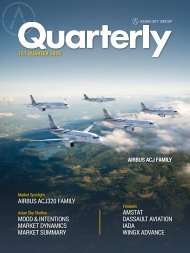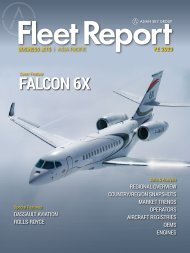China GA Report EN
Create successful ePaper yourself
Turn your PDF publications into a flip-book with our unique Google optimized e-Paper software.
TRAINING SCHOOLS AND PILOTS<br />
PILOT OUTLOOK<br />
According to Boeing’s Annual <strong>China</strong> Market Outlook,<br />
airlines in <strong>China</strong> will spend more than US$1 trillion on<br />
new airplanes over the next two decades to account<br />
for the country’s demand for air travel. Air traffic over <strong>China</strong> is<br />
set to almost quadruple in the next two decades, making it the<br />
world’s busiest market, according to Airbus Group. Faced with<br />
a local shortage of experienced pilots, the industry in <strong>China</strong><br />
has made news as it looked to satisfy the demand.<br />
As of the end of 2016, there were a total of 50,504 Chinese pilot<br />
licenses issued — a stark increase from 27,807, just five years<br />
earlier in 2011. The total number in 2016 includes 3,090 private<br />
pilot licenses (PPL), 26,712 commercial pilot’s license (CPL)<br />
s, 104 multi-crew pilot licenses, and 19,941 air transport pilot’s<br />
licenses (ATPL)s, according to the Annual <strong>Report</strong> of Chinese Pilot<br />
Development 2016.<br />
Projected Airline Pilots by 2036<br />
81,720<br />
8,142<br />
89,862<br />
Pilot demand for increased fleet<br />
Retirement<br />
Total number of new pilot needed<br />
Competition between airlines is increasing around the world.<br />
In <strong>China</strong>, the emergence of low-cost carriers is threatening the<br />
market position of the “Big Three” airlines of <strong>China</strong>. When airlines<br />
can no longer guarantee profit, they are less likely to invest on<br />
cadet pilot programs. The lack of upfront investment on pilots<br />
has since created problems not only on major international<br />
airlines but also smaller one.<br />
Commercial airlines are now more likely to hire self-funded pilots<br />
with sufficient flying hours and corresponding type ratings,<br />
which may intensify the pilot shortage problem in the <strong>GA</strong> sector<br />
of <strong>China</strong>. While the benefits and career prospects of the large<br />
airlines attract the top tiers of cadet pilot and commercial pilot<br />
programs, regional airlines and <strong>GA</strong> airlines suffer from a reduced<br />
pool of pilots.<br />
The pilot demand/supply imbalance problem has been making<br />
headlines in the <strong>China</strong> aviation industry. Worldwide, the industry<br />
needs 617,000 new pilots by 2035 to meet the projected growth<br />
in pilot demand. Approximately 90,000 pilots of the worldwide<br />
demand will be required for <strong>China</strong> — 16% of the global demand<br />
according to ASG’s estimation.<br />
With more than 6,810 new aircraft deliveries in <strong>China</strong> by 2035,<br />
averaging 12 pilots per aircraft, the total demand for commercial<br />
airline pilots by 2035 is 81,720. Coupled with the 8,142 retiring<br />
pilots by 2035, the total demand for pilots comes to 89,862.<br />
<strong>China</strong> would need an extra 4,403 pilots per year to meet the<br />
demand for airline pilots, an 11% growth annually. In 2012, <strong>China</strong><br />
only produced 3,574 pilot graduates, however, the industry has<br />
since benefited from an increase in Part 141 training schools<br />
within <strong>China</strong> — from 12 in 2012 to 22 in 2017. Registered pilots of<br />
all categories increased from 31,381 to 50,504 and pilot growth,<br />
as of 2016 is 4,981.<br />
Airline Pilot Demand and Supply<br />
4,403<br />
4,981<br />
New pilots needed per year<br />
Pilot growth in 2016<br />
Why do we still face a pilot shortage problem in general aviation<br />
when the average growth rate of pilot graduates is higher than<br />
the projected annual additional pilot demand?<br />
At the current rate of pilot production, there are too many first<br />
officers in the commercial airlines. The transition period from<br />
first officer to captain, which requires at least 1,500 flying hours<br />
with an ATPL license, has risen from five to ten years, due to<br />
insufficient flying hours from high competition. However, these<br />
pilots are unwilling to move to the <strong>GA</strong> sector because of low<br />
salary and job prospects with less quality packages.<br />
64 | CHINA <strong>GA</strong> REPORT 2017

















